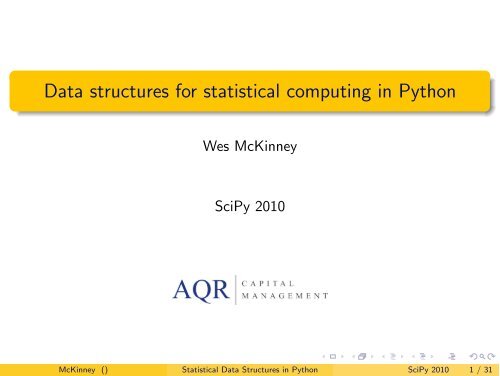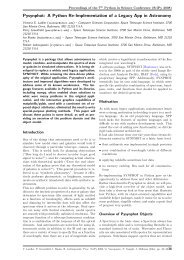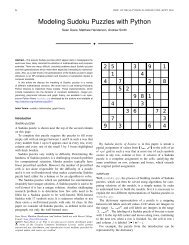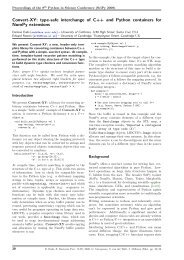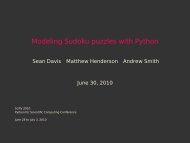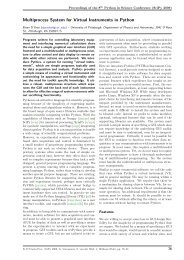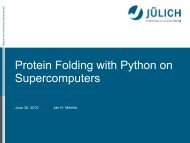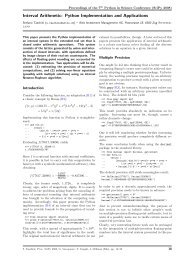Data structures for statistical computing in Python - SciPy Conferences
Data structures for statistical computing in Python - SciPy Conferences
Data structures for statistical computing in Python - SciPy Conferences
You also want an ePaper? Increase the reach of your titles
YUMPU automatically turns print PDFs into web optimized ePapers that Google loves.
<strong>Data</strong> <strong>structures</strong> <strong>for</strong> <strong>statistical</strong> <strong>comput<strong>in</strong>g</strong> <strong>in</strong> <strong>Python</strong><br />
Wes McK<strong>in</strong>ney<br />
<strong>SciPy</strong> 2010<br />
McK<strong>in</strong>ney () Statistical <strong>Data</strong> Structures <strong>in</strong> <strong>Python</strong> <strong>SciPy</strong> 2010 1 / 31
Environments <strong>for</strong> statistics and data analysis<br />
The usual suspects: R / S+, MATLAB, Stata, SAS, etc.<br />
<strong>Python</strong> be<strong>in</strong>g used <strong>in</strong>creas<strong>in</strong>gly <strong>in</strong> <strong>statistical</strong> or related applications<br />
scikits.statsmodels: l<strong>in</strong>ear models and other econometric estimators<br />
PyMC: Bayesian MCMC estimation<br />
scikits.learn: mach<strong>in</strong>e learn<strong>in</strong>g algorithms<br />
Many <strong>in</strong>terfaces to mostly non-<strong>Python</strong> libraries (pycluster, SHOGUN,<br />
Orange, etc.)<br />
And others (look at the <strong>SciPy</strong> conference schedule!)<br />
How can we attract more <strong>statistical</strong> users to <strong>Python</strong>?<br />
McK<strong>in</strong>ney () Statistical <strong>Data</strong> Structures <strong>in</strong> <strong>Python</strong> <strong>SciPy</strong> 2010 2 / 31
What matters to <strong>statistical</strong> users?<br />
Standard suite of l<strong>in</strong>ear algebra, matrix operations (NumPy, <strong>SciPy</strong>)<br />
Availability of <strong>statistical</strong> models and functions<br />
More than there used to be, but noth<strong>in</strong>g compared to R / CRAN<br />
rpy2 is com<strong>in</strong>g along, but it doesn’t seem to be an “end-user” project<br />
<strong>Data</strong> visualization and graphics tools (matplotlib, ...)<br />
Interactive research environment (I<strong>Python</strong>)<br />
McK<strong>in</strong>ney () Statistical <strong>Data</strong> Structures <strong>in</strong> <strong>Python</strong> <strong>SciPy</strong> 2010 3 / 31
What matters to <strong>statistical</strong> users? (cont’d)<br />
Easy <strong>in</strong>stallation and sources of community support<br />
Well-written and navigable documentation<br />
Robust <strong>in</strong>put / output tools<br />
Flexible data <strong>structures</strong> and data manipulation tools<br />
McK<strong>in</strong>ney () Statistical <strong>Data</strong> Structures <strong>in</strong> <strong>Python</strong> <strong>SciPy</strong> 2010 4 / 31
What matters to <strong>statistical</strong> users? (cont’d)<br />
Easy <strong>in</strong>stallation and sources of community support<br />
Well-written and navigable documentation<br />
Robust <strong>in</strong>put / output tools<br />
Flexible data <strong>structures</strong> and data manipulation tools<br />
McK<strong>in</strong>ney () Statistical <strong>Data</strong> Structures <strong>in</strong> <strong>Python</strong> <strong>SciPy</strong> 2010 5 / 31
Statistical data sets<br />
Statistical data sets commonly arrive <strong>in</strong> tabular <strong>for</strong>mat, i.e. as a<br />
two-dimensional list of observations and names <strong>for</strong> the fields of each<br />
observation.<br />
array([(’GOOG’, ’2009-12-28’, 622.87, 1697900.0),<br />
(’GOOG’, ’2009-12-29’, 619.40, 1424800.0),<br />
(’GOOG’, ’2009-12-30’, 622.73, 1465600.0),<br />
(’GOOG’, ’2009-12-31’, 619.98, 1219800.0),<br />
(’AAPL’, ’2009-12-28’, 211.61, 23003100.0),<br />
(’AAPL’, ’2009-12-29’, 209.10, 15868400.0),<br />
(’AAPL’, ’2009-12-30’, 211.64, 14696800.0),<br />
(’AAPL’, ’2009-12-31’, 210.73, 12571000.0)],<br />
dtype=[(’item’, ’|S4’), (’date’, ’|S10’),<br />
(’price’, ’
Structured arrays<br />
Structured arrays are great <strong>for</strong> many applications, but not always<br />
great <strong>for</strong> general data analysis<br />
Pros<br />
Fast, memory-efficient, good <strong>for</strong> load<strong>in</strong>g and sav<strong>in</strong>g big data<br />
Nested dtypes help manage hierarchical data<br />
McK<strong>in</strong>ney () Statistical <strong>Data</strong> Structures <strong>in</strong> <strong>Python</strong> <strong>SciPy</strong> 2010 7 / 31
Structured arrays<br />
Structured arrays are great <strong>for</strong> many applications, but not always<br />
great <strong>for</strong> general data analysis<br />
Pros<br />
Fast, memory-efficient, good <strong>for</strong> load<strong>in</strong>g and sav<strong>in</strong>g big data<br />
Nested dtypes help manage hierarchical data<br />
Cons<br />
Can’t be immediately used <strong>in</strong> many (most?) NumPy methods<br />
Are not flexible <strong>in</strong> size (have to use or write auxiliary methods to “add”<br />
fields)<br />
Not too many built-<strong>in</strong> data manipulation methods<br />
Select<strong>in</strong>g subsets is often O(n)!<br />
McK<strong>in</strong>ney () Statistical <strong>Data</strong> Structures <strong>in</strong> <strong>Python</strong> <strong>SciPy</strong> 2010 7 / 31
Structured arrays<br />
Structured arrays are great <strong>for</strong> many applications, but not always<br />
great <strong>for</strong> general data analysis<br />
Pros<br />
Fast, memory-efficient, good <strong>for</strong> load<strong>in</strong>g and sav<strong>in</strong>g big data<br />
Nested dtypes help manage hierarchical data<br />
Cons<br />
Can’t be immediately used <strong>in</strong> many (most?) NumPy methods<br />
Are not flexible <strong>in</strong> size (have to use or write auxiliary methods to “add”<br />
fields)<br />
Not too many built-<strong>in</strong> data manipulation methods<br />
Select<strong>in</strong>g subsets is often O(n)!<br />
What can be learned from other <strong>statistical</strong> languages?<br />
McK<strong>in</strong>ney () Statistical <strong>Data</strong> Structures <strong>in</strong> <strong>Python</strong> <strong>SciPy</strong> 2010 7 / 31
R’s data.frame<br />
One of the core data <strong>structures</strong> of the R language. In many ways similar<br />
to a structured array.<br />
> df
R’s data.frame<br />
Perhaps more like a mutable dictionary of vectors. Much of R’s <strong>statistical</strong><br />
estimators and 3rd-party libraries are designed to be used with<br />
data.frame objects.<br />
> df$isgoog df<br />
item date price volume isgoog<br />
1 GOOG 2009-12-28 622.87 1697900 TRUE<br />
2 GOOG 2009-12-29 619.40 1424800 TRUE<br />
3 GOOG 2009-12-30 622.73 1465600 TRUE<br />
4 GOOG 2009-12-31 619.98 1219800 TRUE<br />
5 AAPL 2009-12-28 211.61 23003100 FALSE<br />
6 AAPL 2009-12-29 209.10 15868400 FALSE<br />
7 AAPL 2009-12-30 211.64 14696800 FALSE<br />
8 AAPL 2009-12-31 210.73 12571000 FALSE<br />
McK<strong>in</strong>ney () Statistical <strong>Data</strong> Structures <strong>in</strong> <strong>Python</strong> <strong>SciPy</strong> 2010 9 / 31
pandas library<br />
Began build<strong>in</strong>g at AQR <strong>in</strong> 2008, open-sourced late 2009<br />
Many goals<br />
<strong>Data</strong> <strong>structures</strong> to make work<strong>in</strong>g with <strong>statistical</strong> or “labeled” data sets<br />
easy and <strong>in</strong>tuitive <strong>for</strong> non-experts<br />
Create a both user- and developer-friendly backbone <strong>for</strong> implement<strong>in</strong>g<br />
<strong>statistical</strong> models<br />
Provide an <strong>in</strong>tegrated set of tools <strong>for</strong> common analyses<br />
Implement <strong>statistical</strong> models!<br />
McK<strong>in</strong>ney () Statistical <strong>Data</strong> Structures <strong>in</strong> <strong>Python</strong> <strong>SciPy</strong> 2010 10 / 31
pandas library<br />
Began build<strong>in</strong>g at AQR <strong>in</strong> 2008, open-sourced late 2009<br />
Many goals<br />
<strong>Data</strong> <strong>structures</strong> to make work<strong>in</strong>g with <strong>statistical</strong> or “labeled” data sets<br />
easy and <strong>in</strong>tuitive <strong>for</strong> non-experts<br />
Create a both user- and developer-friendly backbone <strong>for</strong> implement<strong>in</strong>g<br />
<strong>statistical</strong> models<br />
Provide an <strong>in</strong>tegrated set of tools <strong>for</strong> common analyses<br />
Implement <strong>statistical</strong> models!<br />
Takes some <strong>in</strong>spiration from R but aims also to improve <strong>in</strong> many<br />
areas (like data alignment)<br />
McK<strong>in</strong>ney () Statistical <strong>Data</strong> Structures <strong>in</strong> <strong>Python</strong> <strong>SciPy</strong> 2010 10 / 31
pandas library<br />
Began build<strong>in</strong>g at AQR <strong>in</strong> 2008, open-sourced late 2009<br />
Many goals<br />
<strong>Data</strong> <strong>structures</strong> to make work<strong>in</strong>g with <strong>statistical</strong> or “labeled” data sets<br />
easy and <strong>in</strong>tuitive <strong>for</strong> non-experts<br />
Create a both user- and developer-friendly backbone <strong>for</strong> implement<strong>in</strong>g<br />
<strong>statistical</strong> models<br />
Provide an <strong>in</strong>tegrated set of tools <strong>for</strong> common analyses<br />
Implement <strong>statistical</strong> models!<br />
Takes some <strong>in</strong>spiration from R but aims also to improve <strong>in</strong> many<br />
areas (like data alignment)<br />
Core idea: ndarrays with labeled axes and lots of methods<br />
McK<strong>in</strong>ney () Statistical <strong>Data</strong> Structures <strong>in</strong> <strong>Python</strong> <strong>SciPy</strong> 2010 10 / 31
pandas library<br />
Began build<strong>in</strong>g at AQR <strong>in</strong> 2008, open-sourced late 2009<br />
Many goals<br />
<strong>Data</strong> <strong>structures</strong> to make work<strong>in</strong>g with <strong>statistical</strong> or “labeled” data sets<br />
easy and <strong>in</strong>tuitive <strong>for</strong> non-experts<br />
Create a both user- and developer-friendly backbone <strong>for</strong> implement<strong>in</strong>g<br />
<strong>statistical</strong> models<br />
Provide an <strong>in</strong>tegrated set of tools <strong>for</strong> common analyses<br />
Implement <strong>statistical</strong> models!<br />
Takes some <strong>in</strong>spiration from R but aims also to improve <strong>in</strong> many<br />
areas (like data alignment)<br />
Core idea: ndarrays with labeled axes and lots of methods<br />
Etymology: panel data <strong>structures</strong><br />
McK<strong>in</strong>ney () Statistical <strong>Data</strong> Structures <strong>in</strong> <strong>Python</strong> <strong>SciPy</strong> 2010 10 / 31
pandas <strong>Data</strong>Frame<br />
Basically a pythonic data.frame, but with automatic data alignment!<br />
Arithmetic operations align on row and column labels.<br />
>>> data = <strong>Data</strong>Frame.fromcsv(’data’, <strong>in</strong>dex_col=None)<br />
date item price volume<br />
0 2009-12-28 GOOG 622.9 1.698e+06<br />
1 2009-12-29 GOOG 619.4 1.425e+06<br />
2 2009-12-30 GOOG 622.7 1.466e+06<br />
3 2009-12-31 GOOG 620 1.22e+06<br />
4 2009-12-28 AAPL 211.6 2.3e+07<br />
5 2009-12-29 AAPL 209.1 1.587e+07<br />
6 2009-12-30 AAPL 211.6 1.47e+07<br />
7 2009-12-31 AAPL 210.7 1.257e+07<br />
>>> df[’<strong>in</strong>d’] = df[’item’] == ’GOOG’<br />
McK<strong>in</strong>ney () Statistical <strong>Data</strong> Structures <strong>in</strong> <strong>Python</strong> <strong>SciPy</strong> 2010 11 / 31
How to organize the data?<br />
Especially <strong>for</strong> larger data sets, we’d rather not pay O(# obs) to select a<br />
subset of the data. O(1)-ish would be preferable<br />
>>> data[data[’item’] == ’GOOG’]<br />
array([(’GOOG’, ’2009-12-28’, 622.87, 1697900.0),<br />
(’GOOG’, ’2009-12-29’, 619.40, 1424800.0),<br />
(’GOOG’, ’2009-12-30’, 622.73, 1465600.0),<br />
(’GOOG’, ’2009-12-31’, 619.98, 1219800.0)],<br />
dtype=[(’item’, ’|S4’), (’date’, ’|S10’),<br />
(’price’, ’
How to organize the data?<br />
Really we have data on three dimensions: date, item, and data type. We<br />
can pay upfront cost to pivot the data and save time later:<br />
>>> df = data.pivot(’date’, ’item’, ’price’)<br />
>>> df<br />
AAPL<br />
GOOG<br />
2009-12-28 211.6 622.9<br />
2009-12-29 209.1 619.4<br />
2009-12-30 211.6 622.7<br />
2009-12-31 210.7 620<br />
McK<strong>in</strong>ney () Statistical <strong>Data</strong> Structures <strong>in</strong> <strong>Python</strong> <strong>SciPy</strong> 2010 13 / 31
How to organize the data?<br />
In this <strong>for</strong>mat, grabb<strong>in</strong>g labeled, lower-dimensional slices is easy:<br />
>>> df[’AAPL’]<br />
2009-12-28 211.61<br />
2009-12-29 209.1<br />
2009-12-30 211.64<br />
2009-12-31 210.73<br />
>>> df.xs(’2009-12-28’)<br />
AAPL 211.61<br />
GOOG 622.87<br />
McK<strong>in</strong>ney () Statistical <strong>Data</strong> Structures <strong>in</strong> <strong>Python</strong> <strong>SciPy</strong> 2010 14 / 31
<strong>Data</strong> alignment<br />
<strong>Data</strong> sets orig<strong>in</strong>at<strong>in</strong>g from different files or different database tables may<br />
not always be homogenous:<br />
>>> s1 >>> s2<br />
AAPL 0.044 AAPL 0.025<br />
IBM 0.050 BAR 0.158<br />
SAP 0.101 C 0.028<br />
GOOG 0.113 DB 0.087<br />
C 0.138 F 0.004<br />
SCGLY 0.037 GOOG 0.154<br />
BAR 0.200 IBM 0.034<br />
DB 0.281<br />
VW 0.040<br />
McK<strong>in</strong>ney () Statistical <strong>Data</strong> Structures <strong>in</strong> <strong>Python</strong> <strong>SciPy</strong> 2010 15 / 31
<strong>Data</strong> alignment<br />
Arithmetic operations, etc., match on axis labels. Done <strong>in</strong> Cython so<br />
significantly faster than pure <strong>Python</strong>.<br />
>>> s1 + s2<br />
AAPL 0.0686791008184<br />
BAR 0.358165479807<br />
C 0.16586702944<br />
DB 0.367679872693<br />
F NaN<br />
GOOG 0.26666583847<br />
IBM 0.0833057542385<br />
SAP NaN<br />
SCGLY NaN<br />
VW NaN<br />
McK<strong>in</strong>ney () Statistical <strong>Data</strong> Structures <strong>in</strong> <strong>Python</strong> <strong>SciPy</strong> 2010 16 / 31
Miss<strong>in</strong>g data handl<strong>in</strong>g<br />
S<strong>in</strong>ce data po<strong>in</strong>ts may be deemed “miss<strong>in</strong>g” or “masked”, hav<strong>in</strong>g tools <strong>for</strong><br />
these makes sense.<br />
>>> (s1 + s2).fill(0)<br />
AAPL 0.0686791008184<br />
BAR 0.358165479807<br />
C 0.16586702944<br />
DB 0.367679872693<br />
F 0.0<br />
GOOG 0.26666583847<br />
IBM 0.0833057542385<br />
SAP 0.0<br />
SCGLY 0.0<br />
VW 0.0<br />
McK<strong>in</strong>ney () Statistical <strong>Data</strong> Structures <strong>in</strong> <strong>Python</strong> <strong>SciPy</strong> 2010 17 / 31
Miss<strong>in</strong>g data handl<strong>in</strong>g<br />
>>> (s1 + s2).valid()<br />
AAPL 0.0686791008184<br />
BAR 0.358165479807<br />
C 0.16586702944<br />
DB 0.367679872693<br />
GOOG 0.26666583847<br />
IBM 0.0833057542385<br />
>>> (s1 + s2).sum()<br />
1.3103630754662747<br />
>>> (s1 + s2).count()<br />
6<br />
McK<strong>in</strong>ney () Statistical <strong>Data</strong> Structures <strong>in</strong> <strong>Python</strong> <strong>SciPy</strong> 2010 18 / 31
Categorical data and “Group by”<br />
Often want to compute descriptive stats on data given group designations:<br />
>>> s >>> cats<br />
<strong>in</strong>dustry<br />
AAPL 0.044 AAPL TECH<br />
IBM 0.050 IBM TECH<br />
SAP 0.101 SAP TECH<br />
GOOG 0.113 GOOG TECH<br />
C 0.138 C FIN<br />
SCGLY 0.037 SCGLY FIN<br />
BAR 0.200 BAR FIN<br />
DB 0.281 DB FIN<br />
VW 0.040 VW AUTO<br />
RNO AUTO<br />
F AUTO<br />
TM AUTO<br />
McK<strong>in</strong>ney () Statistical <strong>Data</strong> Structures <strong>in</strong> <strong>Python</strong> <strong>SciPy</strong> 2010 19 / 31
GroupBy <strong>in</strong> R<br />
R users are spoiled by hav<strong>in</strong>g vector recognized as someth<strong>in</strong>g you might<br />
want to “group by”:<br />
> labels<br />
[1] GOOG GOOG GOOG GOOG AAPL AAPL AAPL AAPL<br />
Levels: AAPL GOOG<br />
> data<br />
[1] 622.87 619.40 622.73 619.98 211.61 209.10<br />
211.64 210.73<br />
> tapply(data, labels, mean)<br />
AAPL GOOG<br />
210.770 621.245<br />
McK<strong>in</strong>ney () Statistical <strong>Data</strong> Structures <strong>in</strong> <strong>Python</strong> <strong>SciPy</strong> 2010 20 / 31
GroupBy <strong>in</strong> pandas<br />
We try to do someth<strong>in</strong>g similar <strong>in</strong> pandas; the <strong>in</strong>put can be any function or<br />
dict-like object mapp<strong>in</strong>g labels to groups:<br />
>>> data.groupby(labels).aggregate(np.mean)<br />
AAPL 210.77<br />
GOOG 621.245<br />
McK<strong>in</strong>ney () Statistical <strong>Data</strong> Structures <strong>in</strong> <strong>Python</strong> <strong>SciPy</strong> 2010 21 / 31
GroupBy <strong>in</strong> pandas<br />
More fancy th<strong>in</strong>gs are possible, like “trans<strong>for</strong>m<strong>in</strong>g” groups by arbitrary<br />
functions:<br />
demean = lambda x: x - x.mean()<br />
def group_demean(obj, keyfunc):<br />
grouped = obj.groupby(keyfunc)<br />
return grouped.trans<strong>for</strong>m(demean)<br />
>>> group_demean(s, <strong>in</strong>d)<br />
AAPL -0.0328370881632<br />
BAR 0.0358663891836<br />
C -0.0261271326111<br />
DB 0.11719543981<br />
GOOG 0.035936259143<br />
IBM -0.0272802815728<br />
SAP 0.024181110593<br />
McK<strong>in</strong>ney () Statistical <strong>Data</strong> Structures <strong>in</strong> <strong>Python</strong> <strong>SciPy</strong> 2010 22 / 31
Merg<strong>in</strong>g data sets<br />
One commonly encounters a group of data sets which are not quite<br />
identically-<strong>in</strong>dexed:<br />
>>> df1 >>> df2<br />
AAPL GOOG MSFT YHOO<br />
2009-12-24 209 618.5 2009-12-24 31 16.72<br />
2009-12-28 211.6 622.9 2009-12-28 31.17 16.88<br />
2009-12-29 209.1 619.4 2009-12-29 31.39 16.92<br />
2009-12-30 211.6 622.7 2009-12-30 30.96 16.98<br />
2009-12-31 210.7 620<br />
McK<strong>in</strong>ney () Statistical <strong>Data</strong> Structures <strong>in</strong> <strong>Python</strong> <strong>SciPy</strong> 2010 23 / 31
Merg<strong>in</strong>g data sets<br />
By default glu<strong>in</strong>g these together on the row labels seems reasonable:<br />
>>> df1.jo<strong>in</strong>(df2)<br />
AAPL GOOG MSFT YHOO<br />
2009-12-24 209 618.5 31 16.72<br />
2009-12-28 211.6 622.9 31.17 16.88<br />
2009-12-29 209.1 619.4 31.39 16.92<br />
2009-12-30 211.6 622.7 30.96 16.98<br />
2009-12-31 210.7 620 NaN NaN<br />
McK<strong>in</strong>ney () Statistical <strong>Data</strong> Structures <strong>in</strong> <strong>Python</strong> <strong>SciPy</strong> 2010 24 / 31
Merg<strong>in</strong>g data sets<br />
Return<strong>in</strong>g to our first example, one might also wish to jo<strong>in</strong> on some other<br />
key:<br />
>>> df.jo<strong>in</strong>(cats, on=’item’)<br />
date <strong>in</strong>dustry item value<br />
0 2009-12-28 TECH GOOG 622.9<br />
1 2009-12-29 TECH GOOG 619.4<br />
2 2009-12-30 TECH GOOG 622.7<br />
3 2009-12-31 TECH GOOG 620<br />
4 2009-12-28 TECH AAPL 211.6<br />
5 2009-12-29 TECH AAPL 209.1<br />
6 2009-12-30 TECH AAPL 211.6<br />
7 2009-12-31 TECH AAPL 210.7<br />
McK<strong>in</strong>ney () Statistical <strong>Data</strong> Structures <strong>in</strong> <strong>Python</strong> <strong>SciPy</strong> 2010 25 / 31
Manipulat<strong>in</strong>g panel (3D) data<br />
In f<strong>in</strong>ance, econometrics, etc. we frequently encounter panel data, i.e.<br />
multiple data series <strong>for</strong> a group of <strong>in</strong>dividuals over time:<br />
>>> grunfeld<br />
capita firm <strong>in</strong>v value year<br />
0 2.8 1 317.6 3078 1935<br />
20 53.8 2 209.9 1362 1935<br />
40 97.8 3 33.1 1171 1935<br />
60 10.5 4 40.29 417.5 1935<br />
80 183.2 5 39.68 157.7 1935<br />
100 6.5 6 20.36 197 1935<br />
120 100.2 7 24.43 138 1935<br />
140 1.8 8 12.93 191.5 1935<br />
160 162 9 26.63 290.6 1935<br />
180 4.5 10 2.54 70.91 1935<br />
1 52.6 1 391.8 4662 1936<br />
...<br />
McK<strong>in</strong>ney () Statistical <strong>Data</strong> Structures <strong>in</strong> <strong>Python</strong> <strong>SciPy</strong> 2010 26 / 31
Manipulat<strong>in</strong>g panel (3D) data<br />
What you saw was the “stacked” or tabular <strong>for</strong>mat, but the 3D <strong>for</strong>m can<br />
be more useful at times:<br />
>>> lp = LongPanel.fromRecords(grunfeld, ’year’,<br />
’firm’)<br />
>>> wp = lp.toWide()<br />
>>> wp<br />
<br />
Dimensions: 3 (items) x 20 (major) x 10 (m<strong>in</strong>or)<br />
Items: capital to value<br />
Major axis: 1935 to 1954<br />
M<strong>in</strong>or axis: 1 to 10<br />
McK<strong>in</strong>ney () Statistical <strong>Data</strong> Structures <strong>in</strong> <strong>Python</strong> <strong>SciPy</strong> 2010 27 / 31
Manipulat<strong>in</strong>g panel (3D) data<br />
What you saw was the “stacked” or tabular <strong>for</strong>mat, but the 3D <strong>for</strong>m can<br />
be more useful at times:<br />
>>> wp[’capital’].head()<br />
1935 1936 1937 1938 1939<br />
1 2.8 265 53.8 213.8 97.8<br />
2 52.6 402.2 50.5 132.6 104.4<br />
3 156.9 761.5 118.1 264.8 118<br />
4 209.2 922.4 260.2 306.9 156.2<br />
5 203.4 1020 312.7 351.1 172.6<br />
6 207.2 1099 254.2 357.8 186.6<br />
7 255.2 1208 261.4 342.1 220.9<br />
8 303.7 1430 298.7 444.2 287.8<br />
9 264.1 1777 301.8 623.6 319.9<br />
10 201.6 2226 279.1 669.7 321.3<br />
McK<strong>in</strong>ney () Statistical <strong>Data</strong> Structures <strong>in</strong> <strong>Python</strong> <strong>SciPy</strong> 2010 28 / 31
Manipulat<strong>in</strong>g panel (3D) data<br />
What you saw was the “stacked” or tabular <strong>for</strong>mat, but the 3D <strong>for</strong>m can<br />
be more useful at times:<br />
# mean over time <strong>for</strong> each firm<br />
>>> wp.mean(axis=’major’)<br />
capital <strong>in</strong>v value<br />
1 140.8 98.45 923.8<br />
2 153.9 131.5 1142<br />
3 205.4 134.8 1140<br />
4 244.2 115.8 872.1<br />
5 269.9 109.9 998.9<br />
6 281.7 132.2 1056<br />
7 301.7 169.7 1148<br />
8 344.8 173.3 1068<br />
9 389.2 196.7 1236<br />
10 428.5 197.4 1233<br />
McK<strong>in</strong>ney () Statistical <strong>Data</strong> Structures <strong>in</strong> <strong>Python</strong> <strong>SciPy</strong> 2010 29 / 31
Implement<strong>in</strong>g <strong>statistical</strong> models<br />
Common issues<br />
Model specification (th<strong>in</strong>k R <strong>for</strong>mulas)<br />
<strong>Data</strong> clean<strong>in</strong>g<br />
Attach<strong>in</strong>g metadata (labels) to variables<br />
To the extent possible, should make the user’s life easy<br />
Short demo<br />
McK<strong>in</strong>ney () Statistical <strong>Data</strong> Structures <strong>in</strong> <strong>Python</strong> <strong>SciPy</strong> 2010 30 / 31
Conclusions<br />
Let’s attract more (<strong>statistical</strong>) users to <strong>Python</strong> by provid<strong>in</strong>g superior<br />
tools!<br />
Related projects: larry (la), tabular, datarray, others...<br />
Come to the BoF today at 6 pm<br />
pandas Website: http://pandas.source<strong>for</strong>ge.net<br />
Contact: wesmck<strong>in</strong>n@gmail.com<br />
McK<strong>in</strong>ney () Statistical <strong>Data</strong> Structures <strong>in</strong> <strong>Python</strong> <strong>SciPy</strong> 2010 31 / 31


